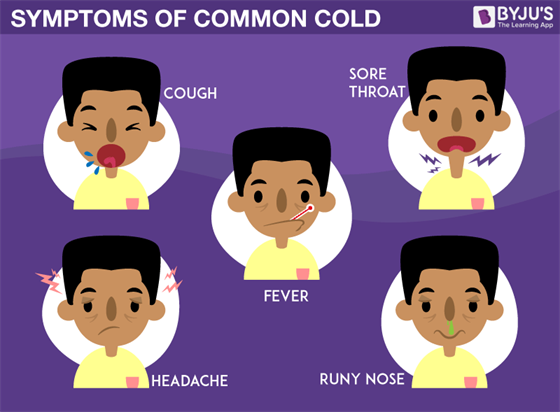An overview of Common Cold
What is Common Cold?
The common cold is a viral infection of your nose and throat (upper respiratorytract). It's usually harmless, although it might not feel that way. Many types ofviruses can cause a common cold.
Healthy adults can expect to have two or three colds each year. Infants and youngchildren may have even more frequent colds.

What causes the common cold?
A cold is caused by any one of several viruses that causes inflammation of themembranes that line the nose and throat. It can result from any one of more than 200different viruses. But, the rhinoviruses causes most colds.
The common cold is very easily spread to others. It's often spread through airbornedroplets that are coughed or sneezed into the air by the sick person. The dropletsare then inhaled by another person. Colds can also be spread when a sick persontouches you or a surface (like a doorknob) that you then touch.
Contrary to popular belief, cold weather or being chilled doesn't cause a cold.However, more colds do occur during the cold season (early fall to late winter).
Signs and symptoms of common cold?
Symptoms of a common cold usually appear one to three days after exposure to acold-causing virus. Signs and symptoms, which can vary from person to person, mightinclude:
1. Runny or stuffy nose
2. Sore throat
3. Cough
4. Congestion
5. Slight body aches or a mild headache
6. Sneezing
7. Low-grade fever
8. Generally feeling unwell
The discharge from your nose may start out clear and become thicker and yellow orgreen as a common cold runs its course. This doesn't usually mean you have abacterial infection.
Can the common cold be prevented?
There are several steps you can take to prevent a cold, including:
Washing your hands : Wash your hands frequently, especially before eating orpreparing food. Also, wash your hands after using the bathroom, wiping your nose orcoming into contact with someone who has a cold.
Avoiding touching your face : Cold viruses spread from your hands to youreyes, nose and mouth.
Cleaning frequently used surfaces : Viruses can live on doorknobs and otherplaces people often touch.
Using hand sanitizers : When you can’t wash your hands with soap and water,use alcohol-based hand sanitizer.
Strengthening your immune system : Get enough sleep, eat a healthy diet andexercise so your body is ready to fight off germs.
Staying home : To make sure you don’t spread the cold to others, stay homewhen you’re sick.
How is common cold diagnosed?
Most common colds are diagnosed based on reported symptoms. However, cold symptomsmay be similar to certain bacterial infections, allergies, and other medicalconditions. Always consult your healthcare provider for a diagnosis if your symptomsare severe.
How is common cold treated?
Here are some tips:
1. Drink plenty of fluids to prevent dehydration.
2. Get plenty of rest.
3. Use over-the-counter medications to manage pain and discomfort.
4. Inhale steam, which may help relieve nasal congestion.
5. Gargle saltwater for a sore throat.
People use various natural remedies for colds. Some, such as drinking warm lemon andhoney, may provide relief. However, not all of them have scientific evidence thatconfirms that they are useful.
Over-the-counter remedies for a cold are available at drugstores, in pharmacies, andonline.
If people develop complications, a doctor may prescribe antiviral medication orantibiotics, depending on the type of complication.
Frequently Asked Questions About common cold
Having a cold during pregnancy isn’t usuallydangerous. But you do need to be careful with what coldmedications you take to treat symptoms. Your healthcare providercan let you know which ones are safe to use during pregnancy.Ifyou think you may have the flu or you develop a fever, youshould contact your provider right away. You may need immediatetreatment.
You can catch a cold any time of year, but it’s morelikely during colder months. In winter, people stay indoors andare in closer contact with each other.A recent study in micesuggests cold temperatures may also affect your immune system’sresponse. Researchers found that when cooler air lowered nosetemperature, mouse immune systems had a harder time stopping therhinovirus from multiplying. The same may be true in humans.
Most colds go away on their own within seven to 10days. Most people recover quickly and the common cold doesn’tlead to anything more serious.
Yes. Colds spread easily from person to person. Foryou to become infected, the virus has to get to one of yourmucous membranes — the moist lining of your nostrils, eyes ormouth. That happens when you touch a surface or breathe moistair that contains the cold virus.For example, when a personwho’s sick sneezes or coughs, they launch droplets of fluidcontaining the cold virus into the air. If you breathe in thosedroplets, the cold virus takes root in your nose. You can alsoleave virus particles on surfaces you touch when you’re sick. Ifsomeone else touches those surfaces and then touches theirnostrils, eyes or mouth, the virus can get in.